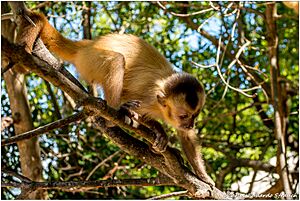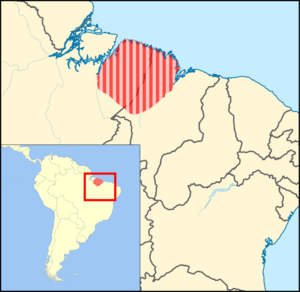Ka'apor capuchin facts for kids
Quick facts for kids Kaapori capuchin |
|
|---|---|
 |
|
| Conservation status | |
| Scientific classification | |
| Genus: |
Cebus
|
| Species: |
kaapori
|
 |
|
| Geographic range in eastern Brazil | |
The Kaapori capuchin (Cebus kaapori) is a type of monkey found only in the Brazilian Amazon. It is also called the Ka'apor capuchin. These monkeys mostly eat fruit, so they are called frugivores. They are known as "gracile capuchins" because they are more slender than other capuchin monkeys.
Their home is a small area in the Amazon, where many people live. Because of this, the Kaapori capuchin's home has been greatly disturbed. This makes them one of the most endangered monkeys in the Americas.
Contents
What is the Kaapori Capuchin?
The Kaapori capuchin was first officially described by a scientist named Helder Queiroz in 1992. For a long time, people thought it was just a type of another monkey, the Wedge-capped capuchin.
Scientists studied their genes and bodies very closely. They found enough differences to decide that the Kaapori capuchin is its own unique species.
How to Identify a Kaapori Capuchin
Kaapori capuchins are part of the Cebus group, which are known as gracile capuchin monkeys. They have longer arms and legs compared to their body size. This is different from the Sapajus group, which are more heavily built.
Adult male Kaapori capuchins weigh about 3 kilograms (6.6 pounds). They have rounder heads and different teeth and jaws. This means they cannot crack open very hard nuts like some other capuchins can. A key difference is that male gracile capuchins do not have tufts of hair on their heads, but all Sapajus males do.
Where Kaapori Capuchins Live
The Kaapori capuchin has one of the smallest living areas of any Cebus monkey in the Amazon. They live in the eastern part of the Brazilian Amazon, near the Atlantic coast. You can find them in the states of Pará and Maranhão.
This region has the most people living in it compared to other parts of the Amazon. Because of so many humans nearby, these monkeys often live in small, separate patches of tall forest. Their home range includes two protected areas: the Gurupi Biological Reserve and the Lago de Turucuí Environmental Protection Area. Even in these protected places, the Kaapori capuchin is quite rare.
Scientists have studied how these monkeys move. One group was seen traveling about 2,175 meters (about 1.35 miles) each day. They used most parts of their home area every month.
Kaapori Capuchin Behavior
What Kaapori Capuchins Eat
Like most capuchins, the Kaapori capuchin is active during the day (diurnal). They live in trees (arboreal) and eat both plants and animals (omnivorous).
Even though they are omnivores, Kaapori capuchins eat a lot of fruit. One study showed that almost 75% of their diet was fruit, like fruit pulp or the soft part of unripe fruit. They also eat arthropods (like insects) (12.6%) and seeds (10.2%).
When they hunt for insects, they use clever methods. They might break leaves to get prey out. They also break branches with their teeth and hands to reach ants inside. Sometimes, they smash snails against trees to crack their shells open.
Social Life and Reproduction
Kaapori capuchins usually live in small groups of fewer than 10 individuals. Sometimes, they even share their living space with other monkeys, like bearded sakis or robust capuchins.
Not much is known about how they mate. However, it is known that babies are usually born between June and July. Kaapori capuchins are polygamous, meaning one male mates with multiple females. Females usually have one baby at a time, and twins are rare. They typically give birth every two years. If a baby dies, the mother might have another baby sooner. Pregnancy lasts about 150 to 180 days.
Threats to Kaapori Capuchins
The Kaapori capuchin is one of the most endangered monkeys in the Amazon. By 2017, their population had dropped by over 80%. The IUCN Red List now lists them as Critically Endangered.
There are many reasons why these monkeys are at such high risk. Some scientists think they are naturally rare and very sensitive to even small changes in their home. However, their habitat has faced huge disturbances. Many people live nearby, leading to a lot of deforestation and environmental damage.
Over 70% of the forest in their area has been cut down. A main reason for this is to create farmland for crops like soy and for cattle pastures. In 1978, the largest hydroelectric dam in Brazil was built within their home range. This project caused terrible damage. It flooded over 2,000 square kilometers (about 770 square miles) and turned land into thousands of islands. This severely damaged the remaining forest, leaving it broken into small pieces.
Like many other Amazon species, the Kaapori capuchin has also been hunted and poached. A big concern for protecting these monkeys is that not enough detailed research has been done on them. To protect them properly, scientists need to understand them much better.


